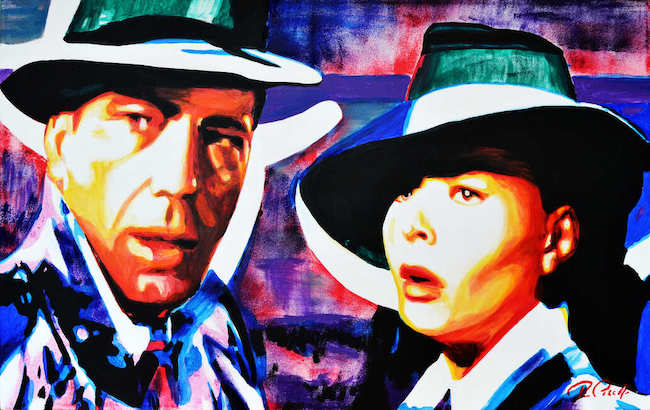La caratteristica che meglio contraddistingue alcuni creativi contemporanei è la poliedricità, intesa come tendenza a misurarsi con differenti linguaggi espressivi, spesso distanti tra loro eppure tutti parte del medesimo universo creativo. La possibilità di conoscere e personalizzare gli stili elaborati nel secolo scorso per adeguarli alla propria indole creativa rende questo tipo di artisti decisamente più liberi di seguire l’impulso spontaneo, senza percepire il vincolo ad adeguarsi solo a un’unica strada che li farebbe sentire imbrigliati all’interno di schemi che non si addicono alla loro indole. Il protagonista di oggi, che abbiamo già conosciuto in due puntate delle scorse settimane, nella serie che andremo a scoprire oggi sceglie di rendere protagoniste le più significative immagini delle scene dei grandi film, quelli che hanno segnato la storia del cinema, che attraverso il suo sguardo innovativo e legato a una forte cromaticità tornano a nuova vita, più moderna e attuale, senza per questo perdere il loro fascino senza tempo.
Gli sperimentali primi decenni del Novecento hanno di fatto proseguito le intuizioni e le aperture generate nel tardo Diciannovesimo secolo da un movimento che si diffuse rapidamente in ogni nazione europea assumendo caratteristiche diverse a seconda del paese di provenienza; l’Arts and Crafts, questo il nome che prese in Inghilterra, fu una corrente per la quale l’artigianato, la decorazione, l’arredamento, potevano legarsi alla forma più alta di arte per generare uno stile di vita nuovo all’insegna della bellezza. Nel Modernismo e nell’Art Nouveau questa contaminazione si ampliò persino verso l’architettura, spianando la strada alle successive interazioni che si svilupparono nell’esperimento della Bauhaus, scuola tedesca di arte e design dove ogni tipo di interazione creativa era funzionale all’esperienza artistica, e al Surrealismo, forse il primo a sconfinare non solo in tutte le arti visive e applicate ma persino nella fotografia e nel cinematografo, comprendendo la rilevanza che potevano assumere nella società, e di conseguenza nel messaggio creativo, quelle immagini fortemente reali e in movimento. Qualche anno dopo, sulla scia delle esperienze surrealiste, la Pop Art diede un nuovo senso al legame tra cinema e arte immortalando gli iconici divi del cinema o i grandi personaggi dell’epoca, caratteristica questa che contraddistinse l’opera di Andy Warhol e che fece da apripista a una serie di successive interazioni importanti tra arte e film ma anche tra arte e musica. Infatti uno dei gruppi più acclamati della scena pop-rock di quella seconda metà del Novecento, i Pink Floyd, si fecero ispirare per le loro copertine proprio dalle atmosfere enigmatiche e improbabili dal Surrealismo di René Magritte e dalle decontestualizzazioni che hanno contraddistinto il lavoro del loro grafico, Storm Thorgerson. Dunque l’arte che poteva entrare nel campo di azione di altre discipline creative, non poteva a sua volta non aprirsi all’interazione e all’introduzione di innovativi approcci pittorici generati proprio dall’evolversi della sinergia con la fotografia e con il cinema. A partire dall’esperienza di Warhol il mondo culturale e in particolare quello artistico, comprese di dover andare verso il popolo, inteso come maggioranza di persone che formavano la società, perché il tenore di vita era cresciuto e tutti dovevano potersi permettere di avere in casa la bellezza generata dall’arte; la riproduzione di scene, personaggi, simboli quotidiani conosciuti si rivelò essere la scelta vincente per avvicinare più persone e per consolidare quella contaminazione tra diverse discipline che nella realtà contemporanea si è integrato come parte stessa dell’espressività. L’artista maltese Ray Piscopo riprende il legame con il cinema che tanto aveva contraddistinto il padre della Pop Art, Andy Warhol, modificandolo però nella sua essenza poiché egli non si limita a ritrarre i volti delle dive e dei divi bensì, nella serie dedicata al cinema, immortala le grandi scene che hanno fatto epoca e che rimangono nella memoria emotiva di tutti gli appassionati del grande schermo, puntando l’accento sulla magia del sentimento.
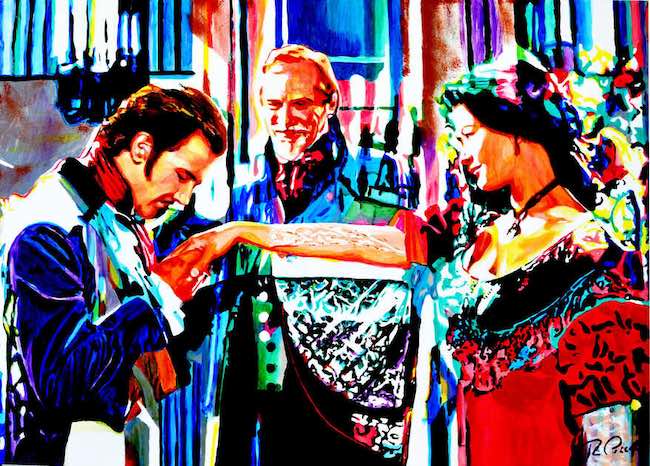
Nel momento in cui la società aveva bisogno di connettersi, di sognare scene che nella realtà non potevano essere vissute, i film costituivano il desiderio inconfessato, il sogno, erano espressione del vivere comune e testimonianze dell’evolversi dei tempi; è per questo che Ray Piscopo decide di regalarsi l’opportunità di andare a riprendere fotogrammi a volte persino dimenticati perché appartenenti a periodi storici ormai lontani.Tuttavia, la sua indole incline a rinnovare tutto ciò che appartiene alla realtà e l’attitudine a concepire la vita in scala cromatica, lo induce a infondere a quelle scene la propria emotività, assecondando così i colori alle sensazioni suscitate in lui nel momento in cui ha visto i film di cui racconta e ammantandoli di quell’alchimia Pop che li rende molto più affascinanti e modaioli. La tecnica utilizzata per realizzare questa serie di tele è quella dell’acrilico, proprio perché le tonalità possono essere facilmente sovrapposte e stratificate pur rimanendo ben distinte, infondendo quella sensazione di irrealtà fortemente probabile, come se la saturazione delle tinte fosse funzionale a rendere i personaggi persino più protagonisti di quanto non lo siano stati nel film originale.
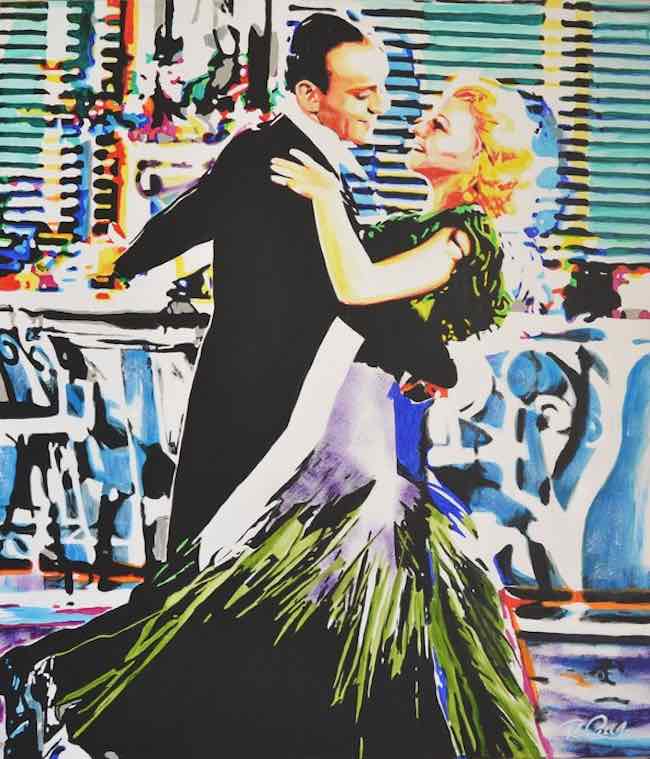
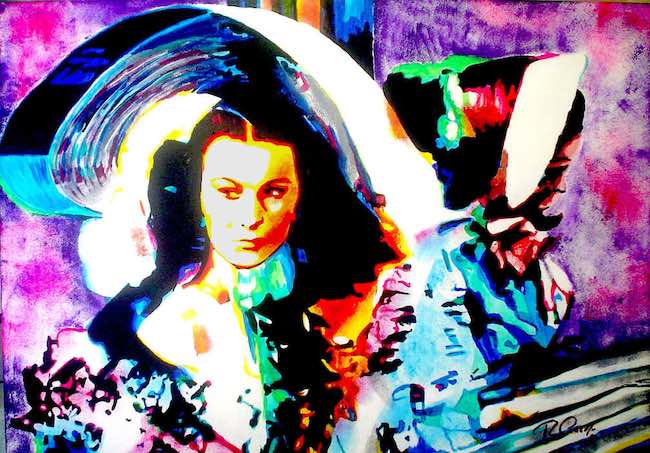
Ciò che domina in questa produzione artistica è l’amore, il momento della vicinanza tra i due attori principali, a volte il bacio, altre invece l’istante in cui l’incantesimo si compie e da quel punto in avanti niente sarà più come prima; emerge dunque l’animo romantico di Ray Piscopo in questi dipinti che coinvolgono sia il pubblico che ha visto quelle pellicole negli anni in cui sono andate sugli schermi, sia quello più giovane che forse ne ha solo sentito parlare ma che non può fare a meno di subire il fascino magnetico della gamma cromatica utilizzata dall’artista per esaltare quegli indimenticabili fotogrammi.
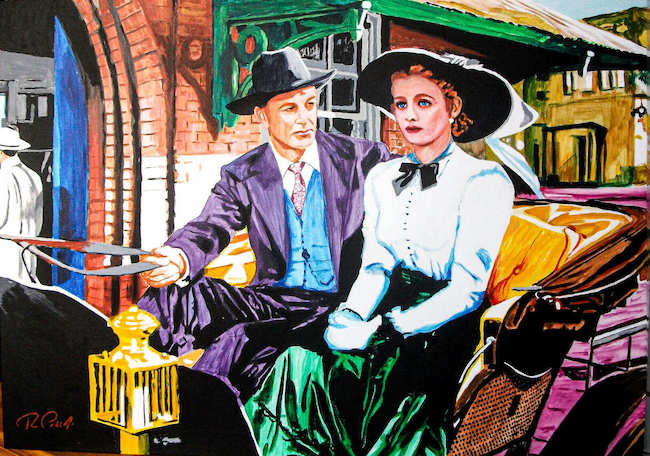
Nell’opera Bright Leaf (Foglie d’oro), Ray Piscopo riesce con una sola scena a sintetizzare tutto il dramma che contraddistingue la trama del film, quell’intreccio di vendetta e desiderio di riscatto che però non trova il lieto fine e che lascia emergere la meschinità e gli eccessi di un’epoca in cui l’onore sembrava essere tutto. La donna sul calesse mostra il disprezzo nei confronti dell’uomo che ritiene responsabile della morte del padre, ma anche la determinazione a farsi sposare pur di raggiungere lo scopo finale, quello di provocare la sua rovina; l’uomo invece ha uno sguardo benevolo nei suoi confronti, ne percepisce la distanza emotiva pur amandola e dunque non può che restare con lei e sperare di sbagliarsi. L’espressione glaciale della donna si contrappone a quella rammaricata di lui e tuttavia la scelta cromatica di Ray Piscopo rende l’insieme meno greve, alleggerisce la tristezza della morale dell’intero film, come a indicare che tutto possa avere una diversa accezione, se solo si cambia il punto di vista.
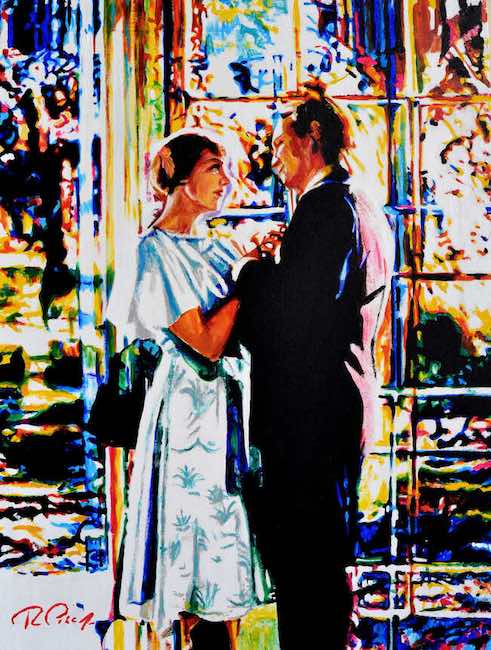
In The sound of music l’artista riproduce una delle situazioni meno iconiche del film Tutti insieme appassionatamente, eppure forse la più romantica, quella in cui Maria e Georg si scoprono innamorati l’uno dell’altra, e in quel frangente raccontato si nasconde tutta la poesia del sentimento più alto e nobile; lo sguardo dei due amanti è rapito e intenso e tutto il resto intorno sembra dissolversi davanti alla magia dell’amore, come se il tempo e il rumore si fossero fermati per rispettare un istante irripetibile. Questo è il motivo per cui Ray Piscopo sceglie di frammentare lo sfondo, di renderlo inconsistente tendendo quasi verso l’Espressionismo Astratto, perché decontestualizzare l’ambientazione è il modo migliore per enfatizzare e mettere in luce la purezza di quel sentimento nascente.
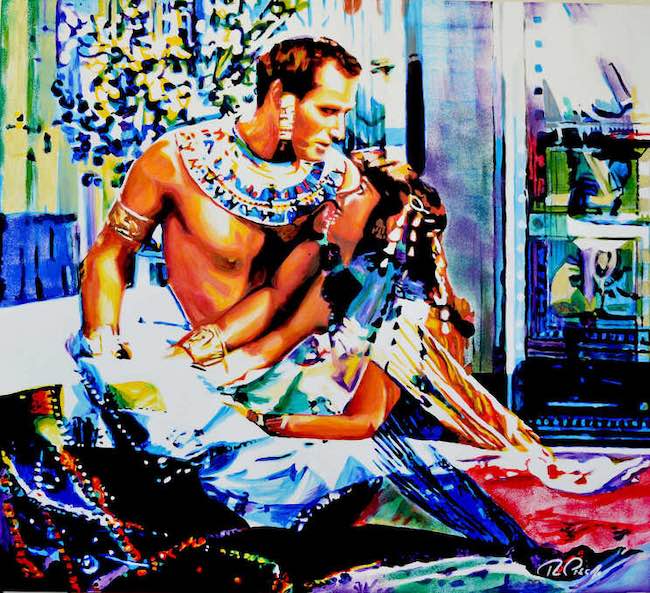
Nella tela The ten comandments (I dieci comandamenti) viene invece raccontato l’amore passionale tra Mosè e Nefertari, ostacolato dal destino eppure in grado di travolgere e di indurre a sacrifici per impedire all’altro di subire conseguenze pericolose; nel momento in cui i due amanti, nel corso della storia, si rincontrano, tutto sembra riaccendersi nonostante la distanza, a dispetto della consapevolezza di dover restare separati. I colori sono vivi, chiari, quasi la luminosità di quel sentimento riuscisse a riempire l’ambiente che li accoglie, mentre la devozione di entrambi fuoriesce sia dai loro sguardi sia anche dall’atteggiamento dei corpi che sembrano fondersi in uno solo, ignari degli eventi epici e tragici che provocheranno il loro definitivo allontanamento; ma in quell’istante reso immortale nell’opera di Ray Piscopo, Mosè e Nefertari stanno semplicemente beandosi della vicinanza e della purezza di un amore contrastato dall’inevitabile destino.
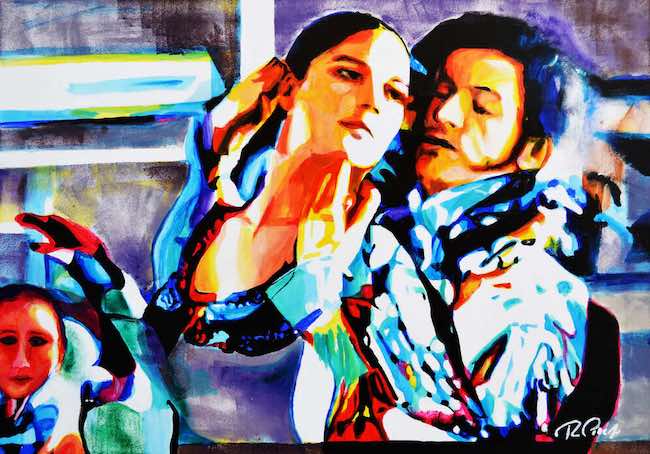
Ray Piscopo sceglie di misurarsi con serie pittoriche attraverso le quali riesce a soddisfare tutti i propri lati creativi, e a sperimentare tecniche ed espressività diverse eppure contigue proprio perché parte della sua poliedrica personalità artistica.
RAY PISCOPO-CONTATTI
Email: piscopoart@gmail.com
Sito web: www.piscopoart.com/
Facebook: www.facebook.com/ray.piscopo
Instagram: www.instagram.com/raypiscopo/
The emotions of the most iconic film scenes in Ray Piscopo’s Pop Art
The characteristic that best distinguishes some contemporary creatives is polyhedrality, understood as the tendency to measure with different expressive languages, often distant from each other yet all part of the same creative universe. The possibility of getting to know and personalise the styles developed in the last century to adapt them to one’s own creative temperament makes this type of artist decidedly freer to follow the spontaneous impulse, without perceiving the constraint of conforming only to a single path that would make them feel trapped within patterns that do not suit their nature. Today’s protagonist, whom we have already met in two episodes of the past weeks, in the series we are going to discover today chooses to make the most significant images of scenes from great movies, those that have marked the history of cinema, which through his innovative gaze and linked to a strong chromaticity come back to new life, more modern and up-to-date, without losing their timeless charm.
The experimental first decades of the 20th century in fact continued the intuitions and openings generated in the late 19th century by a movement that spread rapidly in every European nation, taking on different characteristics depending on the country of origin; Arts and Crafts, this is the name it took on in England, was a current for which craftsmanship, decoration, furnishing, could be linked to the highest form of art to generate a new lifestyle under the banner of beauty. In Modernism and Art Nouveau, this contamination even extended to architecture, paving the way for the subsequent interactions that developed in the Bauhaus experiment, the German school of art and design where every type of creative interaction was functional to the artistic experience, and Surrealism, perhaps the first to encroach not only on all visual and applied arts, but even on photography and cinematography, understanding the relevance that strongly real and moving images could assume in society, and consequently in the creative message. A few years later, in the wake of the Surrealist experiences, Pop Art gave new meaning to the link between cinema and art by immortalising the iconic film stars or great personalities of the time, a characteristic that distinguished Andy Warhol‘s work and which paved the way for a series of subsequent important interactions between art and film, but also between art and music. In fact, one of the most acclaimed groups of the pop-rock scene of the second half of the 20th century, Pink Floyd, were inspired for their covers precisely by the enigmatic and improbable atmospheres of René Magritte‘s Surrealism and the decontextualisations that characterised the work of their graphic designer, Storm Thorgerson.
Thus, art that could enter the field of action of other creative disciplines, could not in turn fail to open itself up to the interaction and introduction of innovative pictorial approaches generated precisely by the evolving synergy with photography and film. Beginning with Warhol‘s experience, the cultural world, and in particular the artistic world, realised that it had to reach out to the people, understood as the majority of persons that made up society, because the standard of living had risen and everyone had to be able to afford to have the beauty generated by art in their homes; the reproduction of scenes, characters, familiar everyday symbols turned out to be the winning choice to bring more people together and to consolidate that contamination between different disciplines that in contemporary reality has become integrated as a part of expressiveness. Maltese artist Ray Piscopo takes up the link with the cinema that had so distinguished the father of Pop Art, Andy Warhol, but modifies it in its essence as he does not limit himself to portraying the faces of divas and stars but, in the series dedicated to the cinema, he immortalises the great scenes that have made the era and remain in the emotional memory of all fans of the big screen, focusing on the magic of feeling. At a time when society needed to connect, to dream of scenes that could not be experienced in reality, films constituted the unconfessed desire, the dream, they were an expression of common living and evidence of the evolution of the times; this is why Ray Piscopo decided to give himself the opportunity to go and film stills that were sometimes even forgotten because they belonged to historical periods that are now distant. However, his inclination to renew everything that belongs to reality and his aptitude for conceiving life on a chromatic scale, induces him to infuse those scenes with his own emotionality, thus conforming the colours to the sensations aroused in him at the moment he saw the films he is recounting and imbuing them with that Pop alchemy that makes them so much more fascinating and fashionable. The technique used to create this series of canvases is acrylic, precisely because the tones can be easily superimposed and layered while remaining distinct, instilling that strongly probable sensation of unreality, as if the saturation of the hues was functional to make the characters even more protagonists than they were in the original film. What dominates in this artistic production is love, the moment of closeness between the two main actors, at times the kiss, at others the instant when the spell is fulfilled and from that point onwards nothing will ever be the same again; Ray Piscopo‘s romantic soul thus emerges in these paintings that involve both the public who saw those films in the years when they went on the screens, and the younger ones who may have only heard of them but who cannot help but be captivated by the magnetic charm of the chromatic range used by the artist to enhance those unforgettable frames.
In Bright Leaf, Ray Piscopo succeeds with a single scene in synthesising all the drama that characterises the film’s plot, that interweaving of revenge and desire for redemption that, however, does not find a happy ending and that reveals the meanness and excesses of an era in which honour seemed to be everything. The woman in the buggy shows contempt for the man she holds responsible for her father’s death, but also a determination to get married in order to achieve her ultimate goal, that of bringing about his ruin; the man, on the other hand, has a benevolent gaze towards her, he perceives her emotional distance even though he loves her and therefore cannot but stay with her and hope he is wrong. The woman’s glacial expression contrasts with his regretful one, and yet Ray Piscopo‘s choice of colour makes the whole less grim, lightens the sadness of the moral of the entire film, as if to indicate that everything can have a different meaning, if only one changes the point of view. In The sound of music, the artist reproduces one of the least iconic situations of the movie, and yet perhaps the most romantic, that in which Maria and Georg discover themselves in love with each other, and in that recounted juncture all the poetry of the highest and noblest sentiment is concealed; the gaze of the two lovers is rapt and intense and everything else around seems to dissolve before the magic of love, as if time and noise had stopped to respect an unrepeatable instant. This is the reason why Ray Piscopo chooses to fragment the background, to make it insubstantial, tending almost towards Abstract Expressionism, because decontextualising the setting is the best way to emphasise and highlight the purity of that nascent feeling. In the canvas The ten commandments, on the other hand, is recounted the passionate love between Moses and Nefertari, hindered by destiny and yet capable of overwhelming and inducing sacrifices to prevent the other from suffering dangerous consequences; when the two lovers meet again in the course of the story, everything seems to rekindle despite the distance, despite the awareness that they must remain separated. The colours are vivid, clear, almost as if the luminosity of that sentiment were able to fill the environment that welcomes them, while the devotion of both emerges both from their gazes and also from the attitude of their bodies that seem to merge into one, unaware of the epic and tragic events that will cause their final estrangement; but in that instant made immortal in Ray Piscopo‘s painting, Moses and Nefertari are simply reveling in the closeness and purity of a love thwarted by inevitable destiny. Ray Piscopo chooses to measure himself with pictorial series through which he manages to satisfy all his creative sides, and to experiment with different yet contiguous techniques and expressiveness precisely because they are part of his multifaceted artistic personality.


